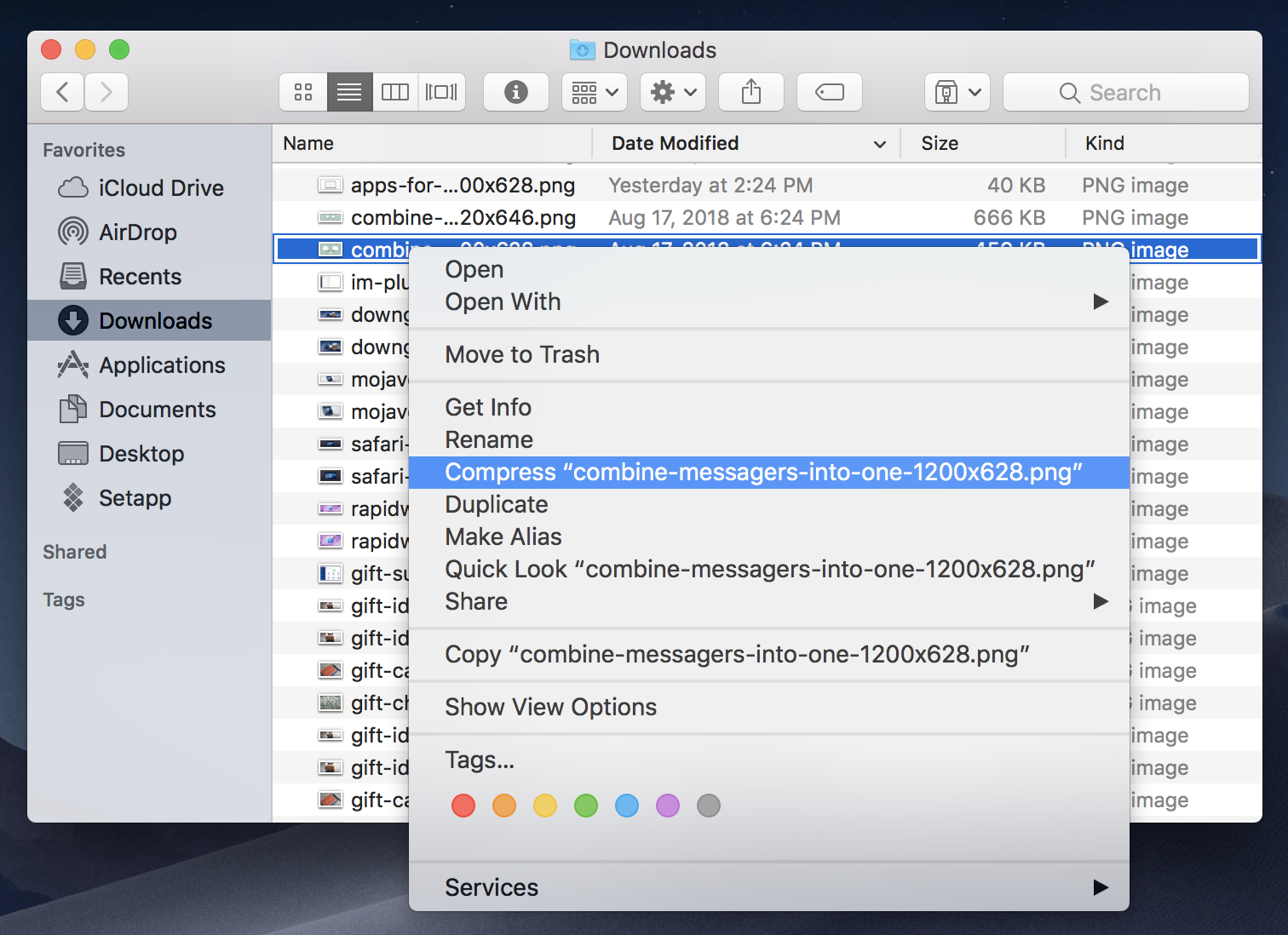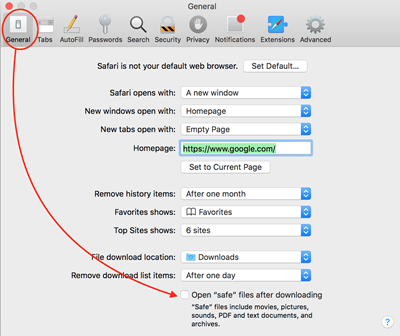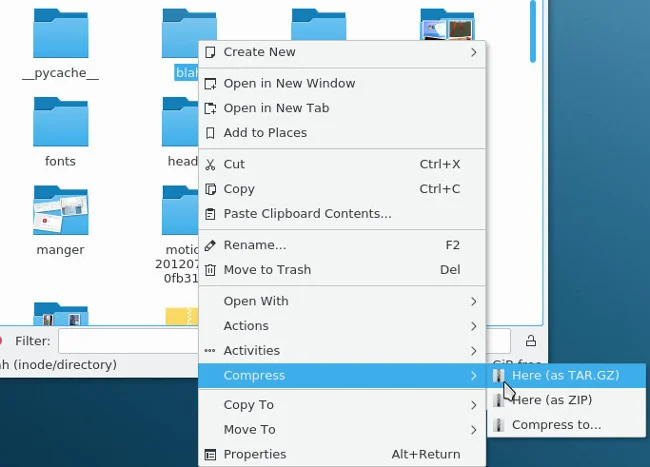Type in unzip file.zip where file is the folder's name, then press Enter to run it. This extracts the files to the current directory. If the file's name has spaces in it, you'll place quotation marks on either side of 'file.zip' (e.g., unzip 'this is a zipped folder.zip'). The Linux unzip command doesn't create a new folder for the unzipped files. Mac OS High Sierra Torrent Download: Download. Note: Let Us Know In comments if any link is not working, We will update ASAP. Specialist recommend to use Mac App Store to download the application on the Mac computers meeting the requirements. First you need to find if your Mac has the characteristics to use High Sierra. The Mac computer.
- D /path/to/extact/location: Unzip an archive to a different directory.-j: Unzip without creating new folders, if the zipped archive contains a folder structure.-l: Lists the contents of an archive file without extracting it.
- How to Unzip a GZ File on macOS Using the Built-In Tool. Like ZIP, you can simply double-click on your GZ archive, and it should start extracting its content. You can do this from any Finder window on your Mac, and your extracted files will be available in a new folder in the same directory as the original GZ archive.
- For the unzip utility, execute a similar command as shown. $ sudo apt install unzip Again, just like zip, you can confirm the version of the unzip utility installed by running. $ unzip -v How to Install Zip/Unzip in RedHa/CentOS/Fedora. Just like on Debian distributions, installing zip and unzip utilities on Redhat distros is quite simple.
The RazorSQL download is a full trial version that includes all features.
The download expires 30 days after the first use. After the expiration, a registration code / serial number
must be purchased to continue using RazorSQL.
RazorSQL is a desktop application that provides users with the ability to query, edit, browse,and manage databases. To download RazorSQL, click the 'Download' link next to the text below that best describes your computer. Please see the links below for installation and uninstallation procedures for the variousoperating systems supported by RazorSQL.
Windows (64-bit)(with installer)
 Downloadrazorsql9_3_3_setup_x64.exe65.9 MBRuns on 64-bit machines only. 32-bit version recommended for ODBCWindows (32-bit)
Downloadrazorsql9_3_3_setup_x64.exe65.9 MBRuns on 64-bit machines only. 32-bit version recommended for ODBCWindows (32-bit)(with installer)Downloadrazorsql9_3_3_setup.exe63.9 MBRuns on both 32-bit and 64-bit machines. 32-bit version recomended if using ODBC connections.Windows (64-bit)
(no installer)
 Download
Download razorsql9_3_3_windows_x64.zip101 MBNo admin rights required. Unzip and launch razorsql.exe. 32-bit version recommended for ODBCWindows (32-bit)
razorsql9_3_3_windows_x64.zip101 MBNo admin rights required. Unzip and launch razorsql.exe. 32-bit version recommended for ODBCWindows (32-bit)(no installer)Downloadrazorsql9_3_3_windows.zip98.5 MBNo admin rights required. Unzip and launch razorsql.exe. 32-bit version recomended if using ODBC connections.macOS
11.0 Big Sur
Unzip To Folder Mac Terminal
10.15 Catalina10.14 MojaveDownloadrazorsql9_3_3.dmg80.2 MBNotarized version requires macOS Big Sur 11.0, Catalina 10.15, or Mojave 10.14Mac OS X
Lion - High Sierra VersionDownloadrazorsql9_3_3_x64.dmg84.7 MBRequires OS X 10.7 - macOS 10.14
| File Type | Link | File Name | Size | Notes |
| Linux (64-bit) | Download | razorsql9_3_3_linux_x64.zip | 103 MB | For 64-bit systems |
| Linux (32-bit) | Download | razorsql9_3_3_linux_x86.zip | 107 MB | For 32-bit systems |
| Solaris / Unix | Download | razorsql9_3_3.zip | 66.8 MB | Requires Java 1.8 or newer |
For existing licensed users, to check to see whether your license is eligible for a free upgrade to the latest version of RazorSQL, click the following: RazorSQL Upgrade Information
Installation Instructions and Requirements
Windows (Native Installer)
For best results, use of one of the following operating systems isrecommended: Windows 10, Windows 8, Windows 7, Windows Vista, or Windows Server 2003 or later. The 32-bit version of RazorSQLruns on both 32-bit and 64-bit versions of Windows. The 64-bit version only runs on 64-bit versions of Windows. If using ODBCdrivers to connect, the 32-bit version is recommended assuming 32-bit ODBC drivers are available.
To install, download the razorsql9_3_3_setup.exe file to your Windows machine.Launching the exe file executes the windows installer. Follow the prompts to installRazorSQL.
Windows (Zip File)
For best results, use of one of the following operating systems isrecommended: Windows 10, Windows 8, Windows 7, Windows Vista, or Windows Server 2003 or newer. RazorSQLruns on both 32-bit and 64-bit versions of Windows. If using ODBCdrivers to connect, the 32-bit version is recommended assuming 32-bit ODBC drivers are available.
To install, download the razorsql9_3_3_windows.zip file to your Windows machine.Extract the zip file. Open the extracted directory and launch razorsql.exe.
macOS and Mac OS X
RazorSQL requires either macOS Big Sur, macOS Catalina, macOS Mojave, macOS High Sierra, macOS Sierra or OS X 10.7, 10.8, 10.9, 10.10, or 10.11.Note: the latest versions of RazorSQL no longer include powerpc (ppc) launchers for older Macs.For best results, use of one of the following operating systems isrecommended: macOS Big Sur, macOS Catalina, macOS Mojave, macOS High Sierra, macOS Sierra, OS X 10.11 (El Capitan), OS X 10.10 (Yosemite), OS X 10.9 (Mavericks), OS X 10.8 (Mountain Lion), OS X 10.7 (Lion).
Note: The notarized version of RazorSQL - razorsql9_3_3.dmg, will not run on Mac versions prior to 10.13 (High Sierra). Big Sur, Catalina, or Mojave is recommendedfor this version.
To install, download the razorsql9_3_3.dmg (Big Sur, Catalina, Mojave or High Sierra only) or razorsql9_3_3_x64.dmg (for Lion, Mountain Lion, Mavericks, Yosemite, El Capitan, macOS Sierra, macOS High Sierra, macOS Mojave) file to your machine. Double click the .dmg file. Thisshould open a window showing RazorSQL.app. Drag RazorSQL.app to your Applications folder or whereveryou want it to reside. Double-click the RazorSQL.app file to launch RazorSQL.
Linux
Download razorsql9_3_3_linux_x86.zip for 32-bit systems orrazorsql9_3_3_linux_x64.zip for 64-bit systems.
Unzip the downloaded file either by double-clicking or opening a terminalwindow and typing the following (unzip file_name)
Open a terminal window. Navigate to the directory where you unzipped the file andthen to the razorsql directory (cd razorsql).
Launch the shell script:
Unzip Folder Macbook
sh razorsql.sh (you may need to execute a chmod on razorsql.sh before launching -- chmod 755 razorsql.sh)
Solaris / Unix
RazorSQL requires Java 1.8 or greater.
Download and unzip razorsql9_3_3.zip. Open a terminal window. Navigate to the directory where you unzipped the zip file and then to the razorsql directory.
Either launch the shell script or the executable jar file:
sh razorsql.sh (you may need to execute a chmod on razorsql.sh before launching -- chmod 755 razorsql.sh)

or
java -jar razorsql.jar
If java is not in the path, type the full path to the java program, for example:
/usr/jdk1.8/bin/java -jar razorsql.jar
If using the shell script and java is not in the path, make sure to edit the script so that the full path to java is specified.
Uninstallation Instructions
Windows (Native Installer)
To uninstall RazorSQL installations that were installed via the Windows installer, the Windows Programs and Features /Add Remove Programs control panel option can be used to uninstall RazorSQL. RazorSQL can also be uninstalled byclicking the 'Uninstall RazorSQL' Start menu shortcut under the RazorSQL Start menu group, or by launching thefollowing file:
64-bit: C:Program FilesRazorSQLuins000.exe
32-bit: C:Program Files (x86)RazorSQLuins000.exe
Windows (Zip File)
To uninstall RazorSQL installations that were downloaded via the Windows Zip File option, move the 'razorsql'folder that was created when extracting the zip file to the Trash / Recycle Bin on your Windows system.Then, empty the trash.
macOS / Mac OS X
Unzip To Directory Macro
To uninstall RazorSQL on Mac OS X or macOS systems, drag RazorSQL.app to the Trash on your system. Then, emptythe trash.
Unzip To Directory Macon Ga

Linux
To uninstall RazorSQL on Linux/Unix systems, remove the 'razorsql' folder that was created when extractingthe RazorSQL zip file. This can be done by either dragging the folder to the trash and emptying the trash,or executing the following command via the terminal application: rm -rf razorsql
